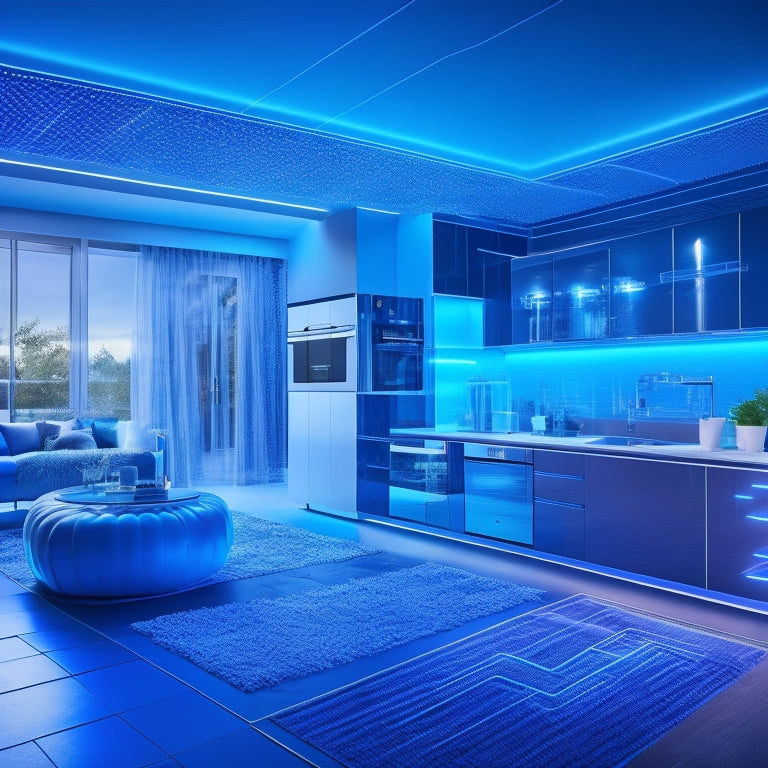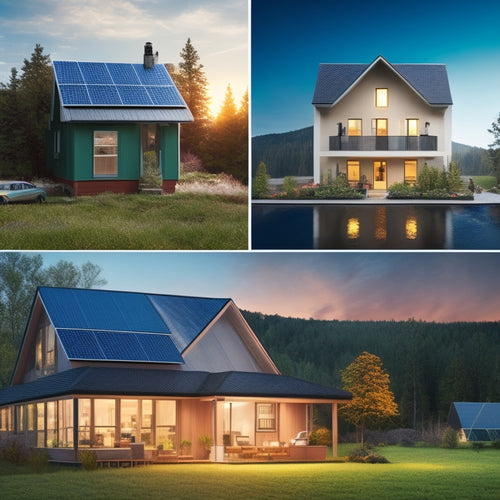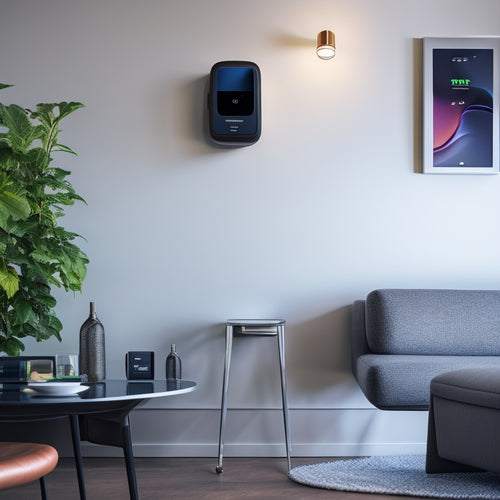
Energy Demand Response Apps: Optimize Your Home's Power
Share
You can optimize your home's power and reduce energy waste by leveraging energy demand response apps, which have been shown to lower energy bills by up to 12% through real-time monitoring and automation. These apps modify your energy consumption patterns based on electricity grid supply changes, encouraging you to shift non-essential loads to off-peak hours. By adjusting thermostats and appliance usage timings, you can make data-driven decisions to lower your energy bills and reduce your environmental impact. Now, uncover how to release the full potential of energy demand response apps and alter your home's energy management.
Key Takeaways
- Energy demand response apps modify consumption patterns based on grid supply changes, encouraging users to shift non-essential loads to off-peak hours.
- Real-time tracking and monitoring tools provide insights into energy consumption patterns, enabling data-driven decisions to lower energy bills and reduce environmental impact.
- Apps that integrate with smart home automation systems learn and adjust to energy usage patterns, streamlining consumption and reducing grid reliance by up to 70%.
- Energy usage forecasting anticipates peak usage periods, allowing users to make adjustments and reduce environmental impact, while also supporting eco-friendly stops and sustainable tourism.
- Real-time cost savings are achieved by adjusting energy usage according to pricing plans, identifying inefficiencies, and accessing tax credits and grants for sustainable energy solutions.
Understanding Energy Demand Response
The concept of energy demand response (DR) revolves around modifying your energy consumption patterns in response to changes in the electricity grid's supply. By participating in DR programs, you contribute to energy conservation and grid reliability.
Peak pricing, a key component of DR, encourages you to shift non-essential loads to off-peak hours, reducing strain on the grid during periods of high demand. As a consumer, you gain awareness of your usage patterns and make behavioral changes, such as adjusting your thermostat or running appliances during off-peak hours.
Incentive programs, like discounts or rebates, motivate you to participate. With accurate usage forecasting, you can optimize your energy consumption and support the integration of renewable resources into the grid.
Top Home Energy Monitoring Apps
You're taking control of your energy usage, and now it's time to access the full potential of energy demand response with the right tools.
Top home energy monitoring apps enable you to make informed decisions about your energy consumption. By adopting a hybrid approach optimizing energy usage, you can maximize your energy efficiency and reduce your carbon footprint.
Apps like Neurio and Sense offer user-friendly interfaces that provide real-time energy usage data, allowing you to identify areas for improvement. With personalized alerts, you'll receive notifications when energy-intensive appliances are in use, enabling you to adjust your habits accordingly.
Other notable apps include Belkin WeMo and TP-Link, which offer seamless integration with smart home devices. By leveraging these apps, you'll gain a deeper understanding of your energy usage and optimize your home's power consumption.
Benefits of Real-Time Energy Tracking
With real-time energy tracking, you'll uncover your unique energy usage patterns, identifying opportunities to optimize your daily habits and reduce waste.
By monitoring your energy consumption in real-time, you'll also be able to reap real-time cost savings, as you'll be alerted to moments of high energy usage and can adjust your behavior accordingly.
This level of visibility will enable you to make data-driven decisions that lower your energy bills and minimize your environmental impact.
For instance, incorporating solar-powered EV chargers can greatly reduce your carbon footprint, and optimizing your energy usage can lead to a more efficient use of energy storage systems.
Energy Usage Patterns
Your home's energy usage patterns are like a fingerprint, unique to your daily habits and routines. By leveraging real-time energy tracking, you gain understanding into your energy usage analysis, enabling you to identify areas of inefficiency.
This information allows you to make informed decisions about your energy consumption, optimizing your daily routines to reduce waste. With the rise of eco-friendly stops, consumers can now charge their electric vehicles while supporting sustainable tourism and local economies.
Consumption forecasting becomes possible, letting you anticipate and prepare for peak usage periods. With this knowledge, you're equipped to take control of your energy usage, making adjustments to reduce your environmental impact and save resources.
Real-Time Cost Savings
As real-time energy tracking provides a granular understanding of your energy consumption, it enables you to capitalize on opportunities for cost savings. You can adjust your energy usage according to fluctuating pricing plans, shifting non-essential loads to off-peak hours when rates are lower. This flexibility in consumer behavior can lead to significant cost reductions.
By monitoring your energy usage in real-time, you can identify areas of inefficiency and make data-driven decisions to optimize your energy consumption. For instance, businesses can reduce their energy bills by up to $2,000+ annually by utilizing solar-powered charging stations.
Additionally, real-time tracking allows you to take advantage of tax credits and grants for sustainable energy solutions. With real-time cost savings, you're in control of your energy expenditure, freeing you from the constraints of traditional fixed-rate plans.
You can optimize your energy usage, reduce your bills, and enjoy the freedom to make choices that work best for you.
Optimizing Home Energy Consumption
You can optimize your home energy consumption by integrating smart home automation systems that learn your energy usage patterns and adjust accordingly.
With real-time monitoring tools, you'll have a clear understanding of your energy usage, allowing you to identify areas for improvement. By leveraging these technologies, you'll be able to streamline your energy consumption and reduce waste.
Furthermore, incorporating on-site renewable energy generation, such as solar power integration, can reduce grid reliance by up to 70%, leading to significant cost savings.
Smart Home Automation
Twenty-first-century smart homes are increasingly reliant on automation to optimize energy consumption, leveraging advanced technologies to streamline energy usage and reduce waste.
As you integrate automation into your home, you'll enjoy greater control over your energy expenditure. Smart thermostat features, for instance, allow you to adjust temperature settings remotely, ensuring your home is comfortable when you need it to be, without wasting energy when you're away.
Additionally, automation security measures safeguard your home's devices from cyber threats, giving you peace of mind.
Energy Usage Patterns
Optimizing home energy consumption relies heavily on understanding your energy usage patterns. To do this, you'll need to analyze your energy consumption trends, identifying when and how you use the most energy.
Peak usage analysis is essential, as it helps you pinpoint the times of day when your energy usage spikes. Are you guilty of blasting the air conditioning during hot summer afternoons? Do you leave lights on throughout the house when you're not home?
Real-Time Monitoring Tools
Armed with a deeper understanding of your energy usage patterns, it's time to tap into the power of real-time monitoring tools.
These innovative features allow you to keep a close eye on your energy consumption, receiving real-time alerts when your usage spikes or dips.
With this information, you can make adjustments on the fly, optimizing your home's energy consumption and reducing waste.
Real-time monitoring tools give you the freedom to take control of your energy usage, making it easier to identify areas for improvement and make data-driven decisions.
Solar Energy Integration Made Easy
Your energy demand response app can seamlessly incorporate solar energy into the grid with advanced integration tools. This means you can optimize your solar panel system's performance and maximize your energy independence.
With solar energy integration, you can:
-
Monitor and control your solar panel's energy output in real-time, ensuring you're generating the most power possible.
-
Optimize energy storage, storing excess energy generated during the day for use during peak hours or at night.
-
Integrate with your photovoltaic system, allowing your app to adjust energy consumption based on your solar panel's energy output, reducing your reliance on the grid.
Energy Efficiency on a Budget
With energy costs on the rise, you're likely looking for ways to reduce your energy expenditure without breaking the bank.
Fortunately, there are several budget-friendly upgrades and DIY energy solutions that can help you achieve energy efficiency on a budget. Start by conducting an energy audit to identify areas in your home where energy is being wasted.
Then, prioritize low-cost upgrades such as sealing air leaks, adding insulation, and installing energy-efficient light bulbs. You can also consider DIY projects like building a solar window heater or creating a living wall to reduce energy consumption.
The Future of Smart Home Energy
Smart home energy management systems are revolutionizing the way you consume energy, and their impact will only continue to grow.
As you become more connected to the smart grid, you'll have greater control over your energy usage and costs. This shift towards residential electrification will enable you to adopt sustainable practices and reduce your carbon footprint.
Here are three ways smart home energy management will shape the future:
-
Energy forecasting and load shifting: You'll be able to anticipate and adjust your energy usage in real-time, reducing peak shaving and strain on the grid.
-
Behavioral observations and demand flexibility: Your energy usage patterns will be analyzed to provide personalized recommendations, allowing you to make informed decisions about your energy consumption.
-
Energy storage and consumer engagement: You'll have the freedom to store excess energy generated from renewable sources, and engage with your energy usage in a more interactive and meaningful way.
Frequently Asked Questions
Can Energy Demand Response Apps Work With Older Homes and Appliances?
You can still optimize your older home's power with energy demand response apps, as long as you have a compatible smart thermostat or appliance with Wi-Fi connectivity, regardless of the age of your home or appliances.
Are Energy Monitoring Apps Compatible With All Types of Energy Meters?
You'll find that many energy monitoring apps are compatible with various types of energy meters, but meter compatibility can vary; research the app's integration capabilities to guarantee seamless connection with your specific meter type.
Do Energy Demand Response Apps Require a Smart Thermostat Installation?
Oh, you thought you could just wing it with energy management? Nope! To access the full potential of energy demand response apps, you'll need a smart thermostat installation, seamless smart technology integration, and a user-centric design that puts your energy freedom in your hands.
Can I Control Energy Usage for Individual Appliances Remotely?
You can control energy usage for individual appliances remotely through appliance control features, allowing you to turn them on/off or adjust settings via mobile apps, giving you flexibility and freedom to manage your energy consumption from anywhere.
Are Energy Demand Response Apps Available for Commercial Properties Too?
You can utilize commercial energy demand response apps to optimize power usage in your office building or retail space, allowing you to reduce energy costs and gain more control over your commercial energy consumption.
Related Posts
-

What Does Your Home Energy Audit Report Reveal?
Your home energy audit report reveals a detailed analysis of your energy consumption patterns, highlighting areas of ...
-

7 Best EV Battery Health Trackers for Homeowners
You can maximize your electric vehicle's performance and lifespan by leveraging advanced battery health trackers that...
-

7 Top HEPA Filters for Green Building Projects
You need a reliable HEPA filter for your green building project that aligns with your sustainable goals and guarantee...


